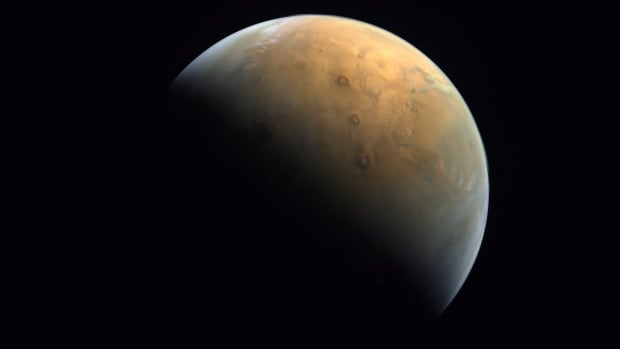Global Courant
A European spacecraft orbiting Mars on Friday sent its first live stream from the red planet to Earth to … 20th anniversary of the launch, but rain in Spain sometimes intervened.
The European Space Agency (ESA) broadcast the livestream with footage from its Mars Express, launched by a Russian rocket from Kazakhstan in 2003.
It took nearly 17 minutes for each photo to reach Earth, nearly 300 million miles away, and another minute to get through the ground stations.
The transmission was sometimes disrupted by rainy weather at the deep space relay antenna in Spain.
Still, enough footage has come through to surprise the European space officials hosting the hour-long live stream. The first images showed about a third of Mars, gradually getting bigger in the frames before getting smaller again as the spacecraft orbited the planet. White clouds were clearly visible in some photos.
LOOK | Mars streamed live by European orbiter:
“If you were aboard the Mars Express right now… this is what you’d see,” said Simon Wood, the mission’s spacecraft engineer.
“Normally we don’t get images this way.”
Photos and other data are usually stored aboard the spacecraft and later sent to Earth, according to Wood, when the spacecraft’s antenna can be pointed this way.
Near real-time images from this far away are “quite rare”, according to ESA. The agency pointed to the live broadcasts of the Apollo moonwalkers more than half a century ago and, more recently, live clips of spacecraft deliberately crashing into the moon and an asteroid.
“These missions were all pretty close to home and others further away maybe sent an image or two in near real time.
When it comes to a long live stream from deep space, this is a first,” ESA said in a statement ahead of the event.
The rain on the plains in Spain cut the number of photos shown. ESA only spent an hour on the live stream because it didn’t want to overload the spacecraft’s batteries.
Mars Express traveled to the red planet with a lander, called Beagle-2, which lost contact with Earth when it tried to hit the surface of Mars.
More than a decade later, NASA’s Mars Reconnaissance Orbiter captured photos from Beagle-2. Although it reached the surface, the lander’s solar panels did not fully unfold.








